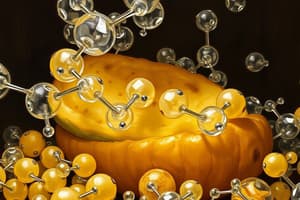Podcast
Questions and Answers
What is the molecular formula for glucose?
What is the molecular formula for glucose?
- C6H12O6 (correct)
- C6H10O5
- C6H14O7
- C12H22O11
Which type of glucose has the hydroxyl group on carbon 1 pointing downwards?
Which type of glucose has the hydroxyl group on carbon 1 pointing downwards?
- δ-glucose
- γ-glucose
- α-glucose (correct)
- β-glucose
What happens during the formation of a glycosidic bond?
What happens during the formation of a glycosidic bond?
- Water is added to the reaction.
- An enzyme converts glucose into fructose.
- A carbon atom loses a hydrogen atom.
- Two monosaccharides are joined through a condensation reaction. (correct)
What is a key advantage of glucose having a ring structure in solution?
What is a key advantage of glucose having a ring structure in solution?
How many hydroxyl groups does glucose have?
How many hydroxyl groups does glucose have?
When glucose dissolves in water, what type of structure does it predominantly form?
When glucose dissolves in water, what type of structure does it predominantly form?
What is the result of a hydrolysis reaction involving a glycosidic bond?
What is the result of a hydrolysis reaction involving a glycosidic bond?
What is the ratio of carbon, hydrogen, and oxygen atoms in glucose?
What is the ratio of carbon, hydrogen, and oxygen atoms in glucose?
Flashcards are hidden until you start studying
Study Notes
Glucose Structure
- Composed of 6 carbon, 12 hydrogen, and 6 oxygen atoms (C6H12O6).
- The molecular ratio of carbon, hydrogen, and oxygen is 1:2:1.
- Contains 5 hydroxyl groups (-OH), contributing to its water solubility due to its polarity.
Molecular Forms
- Exists in two structural forms:
- Straight chain: occurs as a dry powder.
- Ring structure: forms when dissolved in water, resulting in a 6-membered ring where carbon 1 connects to oxygen on carbon 5.
- Two isomers identified:
- α-glucose: hydroxyl group on carbon 1 points downward.
- β-glucose: hydroxyl group on carbon 1 points upward.
Importance of Ring Structure
- More stable in solution compared to the straight-chain form.
- Occupies less space, allowing for the addition of more rings.
- Enhances the energy storage and stability of polymers like glycogen and starch.
Disaccharides and Glycosidic Bonds
- Disaccharides consist of two monosaccharides linked by a glycosidic bond.
- Glycosidic bond formation occurs through a condensation reaction between specific carbon atoms, facilitated by enzymes, which releases a water molecule.
- Glycosidic bond breakage occurs via hydrolysis reaction where water is added, also catalyzed by specific enzymes.
Studying That Suits You
Use AI to generate personalized quizzes and flashcards to suit your learning preferences.




